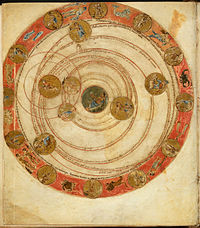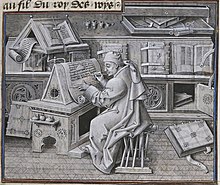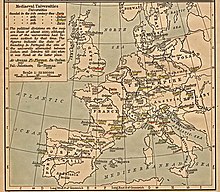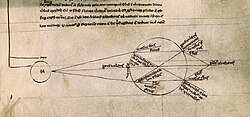European science in the Middle Ages

European science in the Middle Ages comprised the study of nature, mathematics and
According to Pierre Duhem, who founded the academic study of medieval science as a critique of the Enlightenment-positivist theory of a 17th-century anti-Aristotelian and anticlerical scientific revolution, the various conceptual origins of that alleged revolution lay in the 12th to 14th centuries, in the works of churchmen such as Thomas Aquinas and Buridan.[1]
In the context of this article, "Western Europe" refers to the European cultures bound together by the
Western Europe
As Roman imperial power effectively
Early Middle Ages (AD 476–1000)
In the ancient world, Greek had been the primary language of science. Even under the Roman Empire,
As the knowledge of Greek declined during the transition to the Middle Ages, the Latin West found itself cut off from its Greek philosophical and scientific roots. Most scientific inquiry came to be based on information gleaned from sources which were often incomplete and posed serious problems of interpretation. Latin-speakers who wanted to learn about science only had access to books by such Roman writers as

De-urbanization reduced the scope of education and by the 6th century teaching and learning moved to monastic and cathedral schools, with the center of education being the study of the Bible.[5] Education of the laity survived modestly in Italy, Spain, and the southern part of Gaul, where Roman influences were most long-lasting. In the 7th century, learning began to emerge in Ireland and the Celtic lands, where Latin was a foreign language and Latin texts were eagerly studied and taught.[6]
The leading scholars of the early centuries were
Around 800,
The scientific work of the period after Charlemagne was not so much concerned with original investigation as it was with the active study and investigation of ancient Roman scientific texts.[12] This investigation paved the way for the later effort of Western scholars to recover and translate ancient Greek texts in philosophy and the sciences.
High Middle Ages (AD 1000–1300)

Beginning around the year 1050, European scholars built upon their existing knowledge by seeking out ancient learning in Greek and Arabic texts which they translated into Latin. They encountered a wide range of classical Greek texts, some of which had earlier been translated into Arabic, accompanied by commentaries and independent works by Islamic thinkers.[13]
Gerard of Cremona is a good example: an Italian who traveled to Spain to copy a single text, he stayed on to translate some seventy works.[14] His biography describes how he came to Toledo: "He was trained from childhood at centers of philosophical study and had come to a knowledge of all that was known to the Latins; but for love of the Almagest, which he could not find at all among the Latins, he went to Toledo; there, seeing the abundance of books in Arabic on every subject and regretting the poverty of the Latins in these things, he learned the Arabic language, in order to be able to translate."[15]

This period also saw the birth of
The rediscovery of the works of
Scholastics believed in empiricism and supporting Roman Catholic doctrines through secular study, reason, and logic. The most famous was Thomas Aquinas (later declared a "Doctor of the Church"), who led the move away from the Platonic and Augustinian and towards Aristotelianism (although natural philosophy was not his main concern). Meanwhile, precursors of the modern scientific method can be seen already in Grosseteste's emphasis on mathematics as a way to understand nature and in the empirical approach admired by Roger Bacon.

Grosseteste was the founder of the famous Oxford Franciscan school. He built his work on Aristotle's vision of the dual path of scientific reasoning. Concluding from particular observations into a universal law, and then back again: from universal laws to prediction of particulars. Grosseteste called this "resolution and composition". Further, Grosseteste said that both paths should be verified through experimentation in order to verify the principals. These ideas established a tradition that carried forward to Padua and Galileo Galilei in the 17th century.
Under the tuition of Grosseteste and inspired by the writings of Arab
Bacon and Grosseteste conducted investigations into optics, although much of it was similar to what was being done at the time by Arab scholars. Bacon did make a major contribution to the development of science in medieval Europe by writing to the pope to encourage the study of natural science in university courses and compiling several volumes recording the state of scientific knowledge in many fields at the time. He described the possible construction of a telescope, but there is no strong evidence of his having made one.
Late Middle Ages (AD 1300–1500)
The first half of the 14th century saw the scientific work of great thinkers. The logic studies by William of Occam led him to postulate a specific formulation of the principle of parsimony, known today as Occam's razor. This principle is one of the main heuristics used by modern science to select between two or more underdetermined theories, though it is only fair to point out that this principle was employed explicitly by both Aquinas and Aristotle before him.[citation needed][tone]
As Western scholars became more aware (and more accepting) of controversial scientific treatises of the Byzantine and Islamic Empires these readings sparked new insights and speculation. The works of the early Byzantine scholar
. . . after leaving the arm of the thrower, the projectile would be moved by an impetus given to it by the thrower and would continue to be moved as long as the impetus remained stronger than the resistance, and would be of infinite duration were it not diminished and corrupted by a contrary force resisting it or by something inclining it to a contrary motion.
In his turn, Nicole Oresme showed that the reasons proposed by the physics of Aristotle against the movement of the Earth were not valid and adduced the argument of simplicity for the theory that the Earth moves, and not the heavens. Despite this argument in favor of the Earth's motion, Oresme fell back on the commonly held opinion that "everyone maintains, and I think myself, that the heavens do move and not the earth."[17]
The historian of science
By the late Middle Ages the search for
natural philosophers. Although characteristically leaving the door open for the possibility of direct divine intervention, they frequently expressed contempt for soft-minded contemporaries who invoked miracles rather than searching for natural explanations. The University of Paris cleric Jean Buridan (a. 1295–ca. 1358), described as "perhaps the most brilliant arts master of the Middle Ages," contrasted the philosopher's search for "appropriate natural causes" with the common folk's erroneous habit of attributing unusual astronomical phenomena to the supernatural. In the fourteenth century the natural philosopher Nicole Oresme (ca. 1320–82), who went on to become a Roman Catholic bishop, admonished that, in discussing various marvels of nature, "there is no reason to take recourse to the heavens, the last refuge of the weak, or demons, or to our glorious God as if He would produce these effects directly, more so than those effects whose causes we believe are well known to us."[18]
However, a series of events that would be known as the
Renaissance (15th century)

The 15th century saw the beginning of the cultural movement of the Renaissance. The rediscovery of Greek scientific texts, both ancient and medieval, was accelerated as the Byzantine Empire fell to the Ottoman Turks and many Byzantine scholars sought refuge in the West, particularly Italy.
Also, the invention of printing was to have great effect on European society: the facilitated dissemination of the printed word democratized learning and allowed a faster propagation of new ideas.
When the Renaissance moved to Northern Europe that science would be revived, by figures as
Byzantine and Islamic influences
Byzantine interactions
Byzantine scientists preserved and continued the legacy of the great
John Philoponus, a Byzantine scholar in the 500s, was the first person to systematically question Aristotle's teaching of physics.[19] This served as an inspiration for Galileo Galilei ten centuries later as Galileo cited Philoponus substantially in his works when Galileo also argued why Aristotelian physics was flawed during the Scientific Revolution.[20][21]
Islamic interactions
The Byzantine Empire initially provided the medieval Islamic world with
Gallery
-
European output of manuscripts 500–1500[26]
See also
- List of medieval European scientists
- History of science
- Scientific Revolution
- Robert S. Westman.
Notes
- Jordanus Nemorarius. This provoked a deep study of medieval science and cosmology, which he first began publishing in 1913 as Le Système du monde (only five of ten volumes made it to the press before his death). An abridged English translation has been published by Roger Ariew under the title Medieval Cosmology. Cf. Pierre Maurice Marie Duhem Archived 2011-07-26 at the Wayback Machine.
- ^ David C. Lindberg, "The Medieval Church Encounters the Classical Tradition: Saint Augustine, Roger Bacon, and the Handmaiden Metaphor", in David C. Lindberg and Ronald L. Numbers, ed. When Science & Christianity Meet, (Chicago: University of Chicago Pr., 2003), p.8
- ^ William Stahl, Roman Science (Madison: U of Wisconsin P, 1962). See especially pp. 120–33.
- OCLC 185336926.
- ^ Pierre Riché, Education and Culture in the Barbarian West: From the Sixth through the Eighth Century (Columbia: Univ. of South Carolina Pr., 1976), pp. 100–29.
- ^ Pierre Riché, Education and Culture in the Barbarian West: From the Sixth through the Eighth Century (Columbia: Univ. of South Carolina Pr., 1976), pp. 307–23.
- ^ Linda E. Voigts, "Anglo-Saxon Plant Remedies and the Anglo-Saxons," Isis, 70(1979):250–68; reprinted in M. H. Shank, ed., The Scientific Enterprise in Antiquity and the Middle Ages, (Chicago: Univ. of Chicago Pr., 2000).
- ^ Stephen C. McCluskey, "Gregory of Tours, Monastic Timekeeping, and Early Christian Attitudes to Astronomy," Isis, 81(1990):9–22; reprinted in M. H. Shank, ed., The Scientific Enterprise in Antiquity and the Middle Ages, (Chicago: Univ. of Chicago Pr., 2000).
- ^ Stephen C. McCluskey, Astronomies and Cultures in Early Medieval Europe (Cambridge: Cambridge Univ. Pr., 1998), pp. 149–57.
- ^ Faith Wallis, "'Number Mystique' in Early Medieval Computus Texts," pp. 179–99 in T. Koetsier and L. Bergmans, eds. Mathematics and the Divine: A Historical Study (Amsterdam: Elsevier, 2005).
- ISBN 0-8176-2863-0.
- ISBN 978-90-04-16186-3.
- ^ Charles Homer Haskins (1927), The Renaissance of the Twelfth Century (Cambridge: Harvard UP), pp. 278–302.
- OCLC 231712498.
- ISBN 0-674-82360-5.
- ^ Clifford Truesdell (1968), Essays in the History of Mechanics New York: Springer-Verlag.
- ^ Nicole Oresme (1968). Menut, Albert D.; Denomy, Alexander J. (eds.). Le Livre du ciel et du monde. Madison: University of Wisconsin Press. pp. 536–7.
- Ronald L. Numbers(2003). "Science without God: Natural Laws and Christian Beliefs" in When Science and Christianity Meet, edited by David C. Lindberg and Ronald L. Numbers. Chicago: University Of Chicago Press, p. 267.
- ^ "John Philoponus | Encyclopedia.com". www.encyclopedia.com. Retrieved May 7, 2020.
- ^ Lindberg, David. (1992) The Beginnings of Western Science. University of Chicago Press. Page 162.
- ^ "John Philoponus". The Stanford Encyclopedia of Philosophy. Metaphysics Research Lab, Stanford University. 2018.
- ^ "Introduction to Astronomy, Containing the Eight Divided Books of Abu Ma'shar Abalachus". World Digital Library. 1506. Retrieved 2013-07-16.
- JSTOR 1291210.
- doi:10.1086/355661.
- JSTOR 1291210.
- ^ Buringh, Eltjo; van Zanden, Jan Luiten: "Charting the “Rise of the West”: Manuscripts and Printed Books in Europe, A Long-Term Perspective from the Sixth through Eighteenth Centuries", The Journal of Economic History, Vol. 69, No. 2 (2009), pp. 409–445 (416, table 1)
References
- OCLC 668995.
- ISBN 0-521-56762-9.
- ISBN 0-674-82360-5.
- Hannam, James (2011). The Genesis of Science: How the Christian Middle Ages Launched the Scientific Revolution. Washington, DC: Regnery. p. 454. ISBN 978-1-59698-155-3.
- ISBN 0-521-52994-8.
- OCLC 185636619.
- ISBN 0-226-48233-2.
- ISBN 978-0-521-59448-6. Archived from the originalon 2016-03-04. Retrieved 2014-01-17.
- Parkinson, Claire (1985). Breakthroughs. A chronology of great achievements in science and mathematics, 1200-1930. Mansell. ISBN 0-7201-1800-X.
- Restivo, Sal P. (2005). Science, technology, and society: An Encyclopedia. Oxford [Oxfordshire]: Oxford University Press. ISBN 0-19-514193-8.
- Shank, Michael H. (2000). The scientific enterprise in antiquity and the middle ages: readings from Isis. Chicago: University of Chicago Press. ISBN 0-226-74951-7.
- ISBN 0-7661-3646-9.
- Review: Walsh, James J. (March 1909). "The Popes and Science". Ann. Surg. 49 (3): 445–7. PMC 1407075.
External links
- MacKinney Collection of Medieval Medical Illustrations
- Medieval Science, the Church and Universities by James Hannam
- Medieval astrology Archived 2011-06-28 at the Wayback Machine, learning resource from the British Library

![European output of manuscripts 500–1500[26]](http://upload.wikimedia.org/wikipedia/commons/thumb/2/24/European_Output_of_Manuscripts_500%E2%80%931500.png/120px-European_Output_of_Manuscripts_500%E2%80%931500.png)
